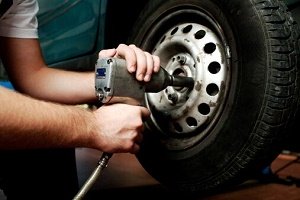
At 106 St. Tire & Wheel, we get a lot of questions about wheel alignments...so we thought it would be a good idea to set the record straight and clear up any misconceptions.
Your car leaves the factory with the wheels set at specific angles for proper drivability, stability, and handling. The crucial alignment angles for the front wheels are toe-in/toe-out, referring to the direction in which a wheel points (relative to a dead-ahead straight line); caster, which refers to the position of the top of the wheel, and camber, which is the offset of the suspension relative to an imaginary vertical straight line behind the wheel. Many newer vehicles also are designed with adjustable rear suspensions, and a four-wheel alignment ensures that the rear wheels' “thrust angle” is at a proper relationship with the front wheels.
There are only two major signs that can indicate improper wheel alignment. One is a persistent pull to the right or left, as an improperly-aligned wheel constantly tries to steer the car in a different direction. The other is uneven wear on the front tires; that tire that is pointed at the wrong direction will be dragged along by the vehicle, scrubbing the tread off the tire at the inside or outside edge. Other signs include a “heavy” or “dead” feeling to the steering response and a steering wheel that doesn't center quickly after rounding a corner...but a pull to one side or worn tires are the two sure clues.
Remember, though, that a pull to one side can also result from a tire that's low on air pressure. In addition, many roads are “crowned” somewhat, meaning the pavement is higher at the center to allow runoff of rainwater. It's not unusual for a car to pull to one side on a crowned road. A poorly-aligned car is one that will pull to one side on straight, level pavement. In fact, if left on its own with no steering input from the driver, a vehicle with a front wheel that's only 1/8” out of spec will drift 28 feet off a straight line over the course of a mile!
Now, on to the misconceptions:
- A poorly-aligned vehicle will not set up a vibration that can be felt through the steering wheel. Vibrations are almost always an indication of a bad tire or a wheel balance issue, not an alignment problem.
- A poorly-aligned vehicle will not cause a side-to-side shimmy in the steering wheel. A shimmy is an indication of steering or suspension problems.
- Excessive play or slop in the steering wheel doesn't mean an alignment problem; it's a sign of steering-system wear.
One thing is for sure. Fighting the steering wheel of a car that constantly tries to drift to one side is more than tiresome and annoying...it costs you money in terms of premature tire wear and decreased fuel economy due to the added friction of a dragging tire. At 106 St. Tire & Wheel, our auto repair techs use the latest in alignment equipment and can bring your car's alignment back to spec again...and the best news is, an alignment is only $45 for most cars. Give us a call, make an appointment and let us get your car's alignment taken care of!